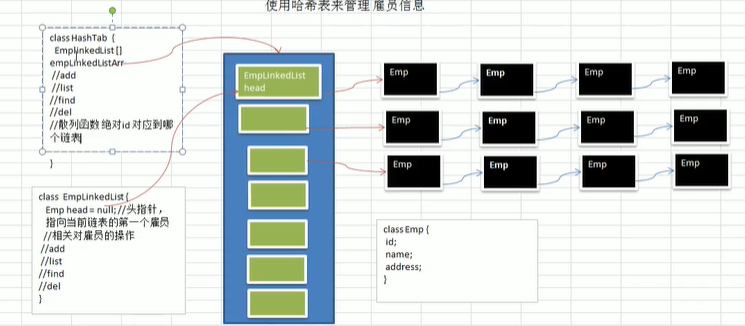哈希表
1.基本介绍
散列表(Hash Table,也叫哈希表),是根据关键码值(Key Value)而直接进行访问的数据结构,也就是说,它通过把关键码值映射到表中一个位置来访问记录,以加快查找的速度,这个映射函数叫做散列函数,存放记录的数组叫做散列表。
2.例题
有一个公司,当有新员工来时,要求将该员工信息加入(id,姓名),当输入id时查询信息

package com.sratct.hashtable;
public class HashTableDemo {
public static void main(String[] args) {
Hashtable hashtable = new Hashtable(7);
Emp emp1 = new Emp(1, "张三");
Emp emp2 = new Emp(2, "李四");
Emp emp3 = new Emp(8, "王五");
hashtable.add(emp1);
hashtable.add(emp2);
hashtable.add(emp3);
hashtable.getList();
hashtable.delete(1);
hashtable.getList();
}
}
// 创建哈希表
class Hashtable {
private EmpLinkedList[] empLinkedListArray;
private int size;
public Hashtable(int size) {
this.size = size;
empLinkedListArray = new EmpLinkedList[size]; // 初始化哈希表
for (int i=0; i<size; i++) {
empLinkedListArray[i] = new EmpLinkedList(); //初始化哈希表中每一个链表
}
}
// 新增雇员
public void add(Emp emp) {
int i = hashFun(emp.id);
empLinkedListArray[i].add(emp);
}
// 遍历雇员
public void getList() {
for (int i=0; i<size; i++) {
empLinkedListArray[i].getList();
}
}
// 根据id查找雇员
public void get(int id) {
int i = hashFun(id);
Emp emp = empLinkedListArray[i].get(id);
if (emp == null) {
System.out.println("未找到该雇员");
} else {
System.out.println(emp.id+ ":" + emp.name);
}
}
//删除雇员
public void delete(int id) {
int i = hashFun(id);
empLinkedListArray[i].delete(id);
}
//编写散列函数,取模
private int hashFun(int id) {
return id % size;
}
}
// 创建雇员表
class Emp {
public int id;
public String name;
public Emp next;
public Emp(int id, String name) {
this.id = id;
this.name = name;
}
}
//创建一个链表,存放雇员
class EmpLinkedList {
// 创建一个无头指针的链表,第一个节点就为第一个雇员,默认为null
private Emp head;
//添加元素
public void add(Emp emp) {
// 如果链表为空,直接插入
if (head == null) {
head = emp;
return;
}
Emp temp = head;
while (temp.next != null) {
temp = temp.next;
}
temp.next = emp;
}
// 遍历雇员
public void getList() {
// 判断链表是否为空
if (head == null) {
System.out.println("没有雇员");
return;
}
Emp temp = head;
while (temp != null) {
System.out.println(temp.id + ":" + temp.name);
temp = temp.next;
}
}
//根据id查找雇员
public Emp get(int id) {
if (head == null) {
System.out.println("没有雇员");
return null;
}
Emp temp = head;
while (temp != null) {
if (temp.id == id) {
return temp; // 找到后返回
}
temp = temp.next;
}
return null;
}
// 删除雇员
public void delete(int id) {
if (head == null) {
System.out.println("没有雇员");
return;
}
Emp temp = head;
while (true) {
if (temp.id == id) {
head = temp.next;
return;
}
if (temp.next.id == id) {
temp.next = temp.next.next;
return;
}
if (temp.next == null) {
System.out.println("未找到");
return;
}
temp = temp.next;
}
}
}